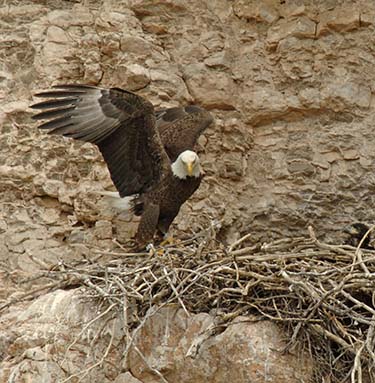
The Conservation Assessment and Strategy for the bald eagle in Arizona details a number of existing and potential threats to bald eagles, their nests, and foraging areas. While a single event may not affect a particular eagle or the eagle population as a whole, multiple events over time could have more impact. The Southwestern Bald Eagle Management Committee acts to halt or lessen negative impacts to bald eagles by monitoring nests with the Arizona Bald Eagle Newtwatch Program, consulting on development projects, protecting important habitat, implementing closures, conducting education and outreach programs, tracking disease and mortality in eagles, and addressing management needs as they happen.
Some of the known threats to eagles
• Habitat alteration/ development: Bald eagles depend on waterways for fish, which makes up the bulk of their diet. The health of riparian systems (rivers, lakes and reservoirs, creeks) throughout Arizona is critical for the continued success of nesting bald eagles. Activities that alter land or water habitat include housing construction, water diversions, agriculture, grazing, off-highway vehicles, and development of recreational facilities.
• Human activity: Nesting bald eagles are impacted by human activities other than development projects. Low-flying aircraft and various forms of recreation may flush eagles from nests or feeding areas and cause nesting attempts to fail.
• Contaminants: Bald eagles are negatively affected by certain contaminants that are released into the environment by human activities. Chemicals designed to kill unwanted plants, rodents, and other pests may inadvertently harm eagles. Lead and mercury poisoning also can kill eagles or prevent them from successfully breeding.
• Parasites and disease: Several species of ticks, mites, and other blood-sucking parasites occur at nests or on eagles. Diseases such as West Nile Virus and aspergillosus are also present at nest areas in Arizona.
• Fishing line: Fishing line (monofilament) has been found in bald eagle nests in Arizona. Although it is rare, nestlings can become entangled in the line and unable to move or eat. To encourage the proper disposal of fishing line, recycling bins for monofilament have been placed at many of our lakes and rivers.
• Electrocution: Eagles sometimes get electrocuted when contacting unprotected powerlines. The Southwestern Bald Eagle Management Committee works with power companies to prevent this by fitting powerline towers with protective guarding and other safety measures.
• Other mortality factors: Eagles can die from many other causes including collision with vehicles, shooting, and natural threats like predation or territorial disputes with other eagles.